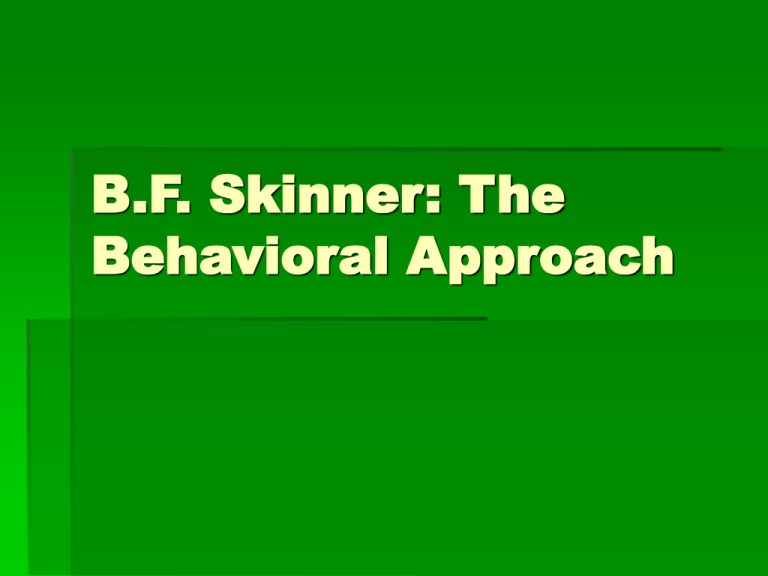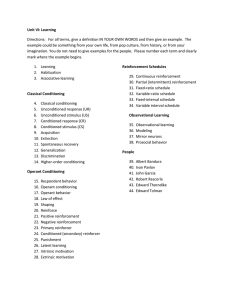B.F. Skinner: The Behavioral Approach
advertisement

B.F. Skinner: The Behavioral Approach Basic Premise Behavior can be controlled by consequences- type of reinforcement following the behavior Kinds of Behavior : Respondent and Operant Respondent behavior: responses made to/elicited by specific environmental stimuli Ex: Reflexes (knee jerk) Depends on reinforcement, directly related to physical stimulus Conditioning: Higher level respondent behavior Learning to substitute one stimulus for another Respondent Behavior and Conditioning Ivan Pavlov: Classical conditioning Dogs salivate to neutral stimulus (sound of owner’s feet) when previously only salivated to sight of food Began sounding bell before and after feeding dogs Eventually began to salivate to sound of bell Demonstrates new meaning to previously neutral stimulus (sound of bell) Conditioned Responses Reinforcement (consequences of behavior) Dogs learn to respond to bell because reward follows (food) Strengthens response, increases likelihood of repeating response in future Extinction Reinforcement is no longer given following the conditioned stimulus Dogs not given food after sound of bell, salivation response eventually stops Kinds of Behavior: Operant Behavior Not all behavior is a direct response to environmental stimuli (respondent beh.) Nature and frequency of behavior determined by reinforcement following behavior Behavior that operates on the environment and changes it Operant Conditioning Change in consequences of response will affect the rate at which the response occurs Most of human behavior learned this way Behaviors that work are frequently displayed; ineffective behaviors are not repeated Personality Schedules of Reinforcement Patterns of rates of providing or withholding reinforcers In everyday life, behavior is rarely reinforced every time it occurs Successive Approximation Acquiring complex behaviors Reinforce as behavior comes closer to resembling the desired final behavior Ex: Child learning to speak Self-Control of Behavior Behavior is controlled/modified by external sources Nothing inside us (no internal processes) determines behavior We can alter the impact of external events through self-control Self-Control Strategies Stimulus avoidance: Stay away from certain external stimuli Self-administered satiation: Cure bad habits by overdoing the behavior Aversive stimulation: Unpleasant consequences Self-reinforcement: Reward ourselves Applying Operant Conditioning: Behavior Modification Behavior modification: apply principles of reinforcement to bring about behavioral changes Token economy: tokens given as reinforcement for positive behaviors, later redeem tokens for rewards Positive Reinforcement, Negative Reinforcement and Punishment Positive reinforcement: Strengthen response by providing desirable rewards Ex: Token economy Negative reinforcement: Strengthen response by removing aversive stimuli Ex: Prisoners-early release for good behavior Punishment: Use aversive stimulus following response to decrease likelihood of behavior in the future Assessment in Skinner’s Theory Functional Analysis Frequency of behavior Situation in which behavior occurs Reinforcement for behavior Must be evaluated to implement behavior modification plan Direct Observation of Behavior Direct observation Self-reports: interviews and questionnaires Physiological measurement: heart rate, muscle tension, brain waves See effects of various stimuli on the body Research: Reversal Experimental Design Baseline: Subject’s normal behavior before beginning experiment Conditioning: IV introduced- should produce a change from baseline behavior Reversal: Remove IV influence to determine if IV is responsible for change from baseline behavior Reconditioning: Reintroduce IV provided it is responsible for change from baseline behavior Criticisms of Skinner Behavior is more than stimulus-response (Bandura- mediating thoughts) Behavior is not totally determined by externals Overly simplistic explanation for human behavior Contributions of Skinner Emphasis on measuring observable behaviors, instead of unobservable constructs (unconscious) Role of reinforcement in shaping behavior Practical usage of theory Considerable research support







